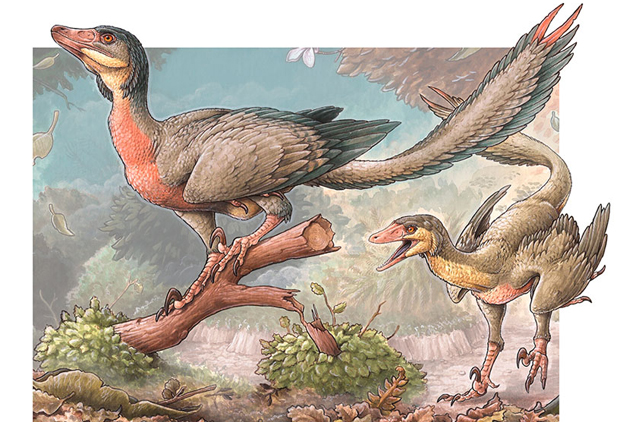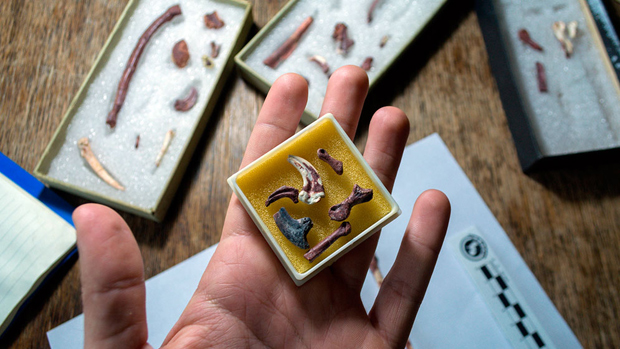Overoraptor chimentoi – Closer to Birds than Most other “Raptors”
Time for Everything Dinosaur team members to catch up on their reading. Whilst browsing through the various press releases, emails and news bulletins from around the world, our attention was drawn to the scientific description of a new, gracile “raptor” from the Upper Cretaceous of Argentina. Named Overoraptor chimentoi, fossils of this 1.3 metre-long, theropod dinosaur were first discovered in 2013 during field work on 90 million-year-old strata associated with the Huincul Formation in the Patagonian province of Rio Negro.
Further fossils were found during excavations in the same area in 2018. Although fragmentary, the bones of this small dinosaur suggest that it was more closely related to that lineage of dinosaurs that led to the birds than it is to the likes of Velociraptor and other dromaeosaurids.
A Life Reconstruction of a Pair of Overoraptor chimentoi

Picture credit: Gabriel Lio
Overoraptor chimentoi – A Very Bird-like Theropod
The fossil record of members of the Eumaniraptora group of dinosaurs known from the southern hemisphere is sparse. Evidence of those “raptors” that were closely related to that branch of this group that led to the modern birds is even rarer. At present, (2020), the fossil evidence is limited to the Unenlagiinae (mostly from the Late Cretaceous of Argentina such as Buitreraptor [B. gonzalezorum]) and the bizarre, bird-like Rahonavis (R. ostromi) from the Upper Cretaceous Maevarano Formation of north-western Madagascar.
Overoraptor exhibits a range of anatomical traits. The feet and legs are very typical of a dromaeosaurid. There is the second toe “killing claw” associated with the “raptors” and the lower limb bones indicate that this was a fast-running, cursorial predator. However, the upper limb bones are very different. The ulna for example, is very robust and long, reminiscent of the upper limb bones of modern birds.
The Fragmentary Fossils of Overoraptor chimentoi
Picture credit: Museo Argentino de Ciencias Naturales “Bernardino Rivadavia”
The picture above shows the fragmentary fossils associated with the new species – Overoraptor chimentoi. The genus name is from the Spanish “overo” which means piebald, a reference to the mixed colour of the fossil bones. The trivial name honours Roberto Nicolás Chimento who found the first remains.
Close to the Bird Part of the Dinosaur Family Tree
A phylogenetic analysis conducted by the researchers revealed that Overoraptor was closely related to Rahonavis, that roamed Madagascar some twenty million years later. The analysis suggests that these two dinosaurs are descended from a common ancestor (they form a monophyletic clade). Together they are stem avialans within the Eumaniraptora, a line of theropods in which some flight-related adaptations of the forelimbs are present in non-flying taxa.
Commenting on the importance of Overoraptor, one of the co-authors of the paper, Fernando Novas (Museo Argentino de Ciencias Naturales “Bernardino Rivadavia”) stated:
“Contrary to what we originally assumed, the Overoraptor is not part of the Unenlagia family, but from another group including a Madagascan species called Rahonavis.”
The discovery of Overoraptor sheds light on the acquisition of flight-related traits in non-avian dinosaurs and on the still poorly known paravian radiation in Gondwana.
The scientific paper: “New theropod dinosaur from the Upper Cretaceous of Patagonia sheds light on the paravian radiation in Gondwana” by Matías J. Motta, Federico L. Agnolín, Federico Brissón Egli and Fernando E. Novas published in The Science of Nature.
The Everything Dinosaur website: Everything Dinosaur.







Leave A Comment